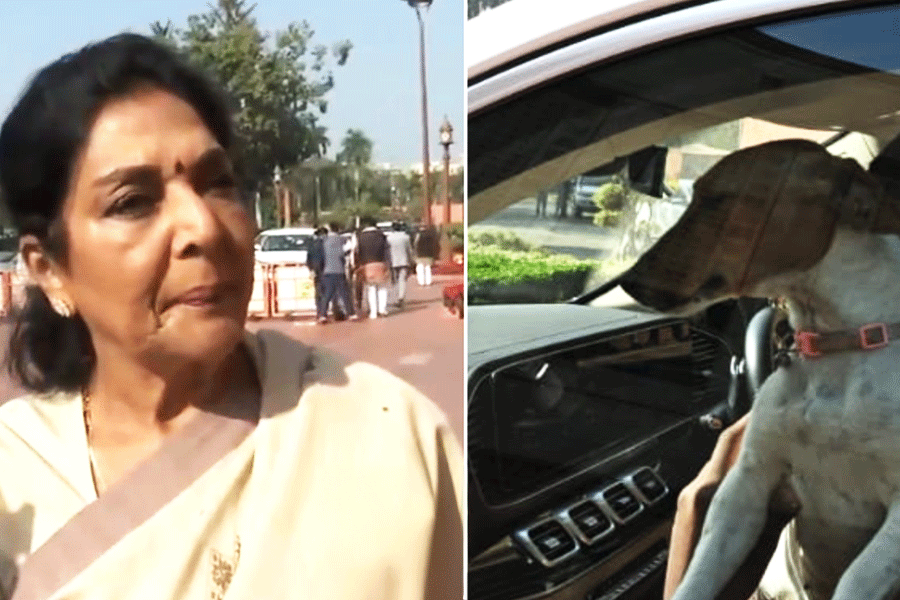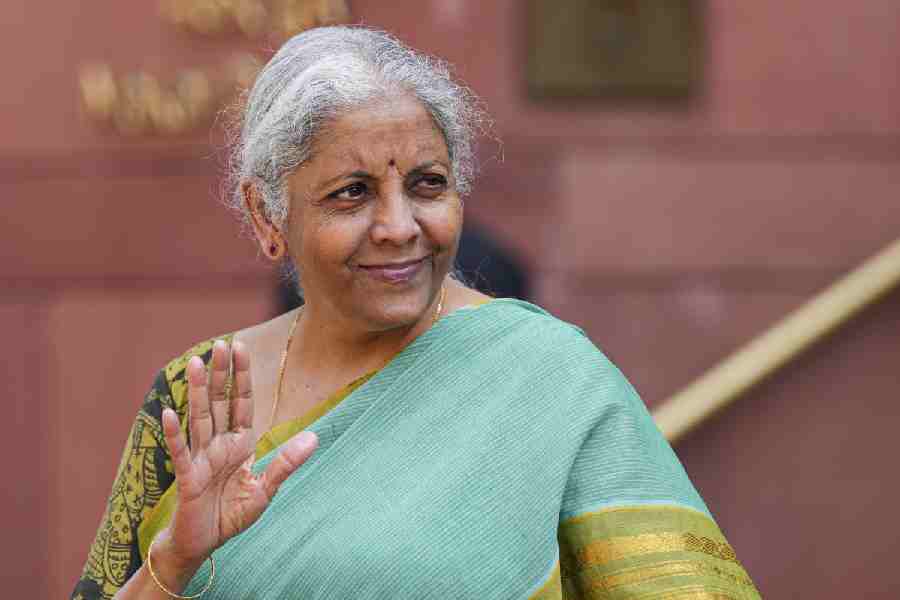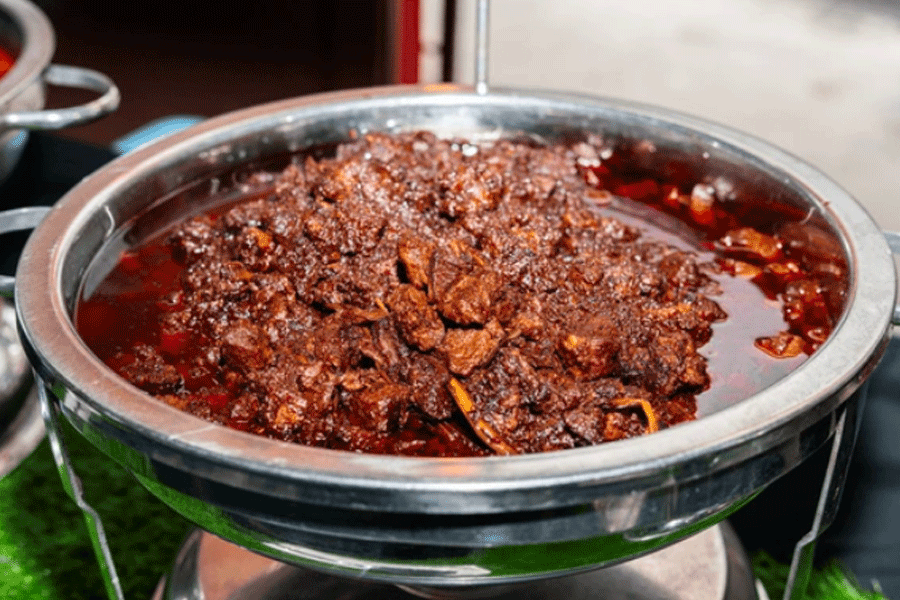 |
Soumitra Das hears of the Radhachura trees that luxuriated on CR Avenue between MG Road and Bowbazar. This is the second in the series on the road
Bimal Mitra’s blockbuster Saheb Bibi Golam begins with a scene showing the Bowbazar area being dug up to make way for what was known as Central Avenue. Underneath the rubble of a huge mansion the Calcutta Improvement Trust discovers the skeleton of a woman who had been married into a patrician family but murdered for her intransigence.
It is possible to delve deeper into the history of this road, known as Chittaranjan Avenue now, by simply taking a walk down this thoroughfare, though, what with their squatters and mobile eateries, the pavements are non-existent. A flaneur can chance upon a firm, now defunct, that was responsible for constructing at least one Calcutta landmark and several buildings on CR Avenue whose hallmark is an eclectic architectural style. One can also find out why many of the buildings on this stretch look forlorn and uninhabited, particularly once darkness sets in.
It is difficult to believe that this gloomy, grotty room at 117 B, CR Avenue is the office of N. Guin & Company that had designed and constructed the Birla Industrial and Technological Museum. We gather from a handout printed on the occasion of his shradh that Nundlal Guin (1874-1963) of Serampore had passed out from the Government School of Art in 1896, at a time when in order to be a draftsman one had to be a Jack of all trades and master of them too.
After stints in leading architectural and engineering firms, Guin joined the E.B.S. Railway drawing department where he prepared the elevation of the proposed Central Railway station and also drew the plan and elevation of the Delhi Durbar station. In 1915, he became head of the department.
When King George V visited Calcutta, Guin landed the job of putting up the temporary amphitheatre for the royal reception at the Maidan. Then he started private practice as an engineer and architect, and the building that housed his office was one of his first assignments, say his only living son, Pashupati, now in his 80s, and grandson Mihir Baran. Besides conceiving and constructing many of the CR Avenue buildings that belong to the great Marwari seths, Kolay market and Mehta Building, Guin had the rare honour of becoming a member of the Engineering Association of India. But for the past 10 years or so, N. Guin & Company has been on the verge of folding up and has been wiped out from public memory.
One of the N. Guin houses stands at the corner of Mohammad Ali Park. The courtyard is marble. A huge chunk of the stucco garlands around the courtyard lies on the floor. There I meet Gautam Jain, 23, a commerce graduate, who, like myself, is seeking cover from the unseasonal rain. He used to live in that house with his family once, but now, like many other tenants, they have moved elsewhere, to the city outskirts.
Jain could have been telling the story of the hundreds of Marwari families who had moved from Burrabazar to CR Avenue, when it was being constructed, but had uprooted themselves once again in search of greener pastures.
His grandfather had fallen out with his own father and decided to leave Burrabazar. Fortunately, he knew the landlord of the house adjoining their present residence. “My grandfather began to live on the third floor of that building at a monthly rent of 10 paise. My grandmother became friends with the landlady of the neighbouring house. So they moved in. My father was born there. I, too, was born there but now we don’t live there any longer.”
Jain speaks of a time, not so long ago, when 30-40 families used to live in that mini-township, two to three rooms per family, with common bathrooms and toilets. “Fisticuffs, particularly among the ladies who went to fetch water, were routine each morning. The landlord is denying us permission to change over to AC. Only the landlord can use the lift. So over the past seven years or so, tenants have moved out although they have not surrendered their rooms. “Earlier, the building hummed with activity, now you can hear the mosquitoes in the dark. Only six or seven families are left. I come every evening for puja.”
He indicates the desolate floors. But those who have stayed on enjoy an unlimited supply of water and a relatively clean lavatory. He points to buildings of equally noble proportions as the one which used to be his residence that look as if they have been abandoned. The unoccupied rooms stand out by virtue of their fresh whitewash.
A house opposite Islamia Hospital has a strangely spelt signboard — actually a metal cutout, I discover later. Seemingly economising on the last letters of both words, it reads: DUT HOUS. The staircase leads to a terrace garden. Kalyan Dutt, 58, one of the owners of this building, says his grandfather was one of the founder members of Bengal Chemical, and from 1929 it housed the firm’s office till 1957. So no less a man than the great humorist Rajshekhar Basu had worked here. During the 1947 riots, his family had to flee the area, when their tenant, a Muslim doctor, looked after it for two years. That Muslim doctor’s son is now the 67-year-old G.M. Rahman, a dentist. He still lives there with his family.
Dutt says slums were razed to make way for the Metro buildings. The Chinese community thrived in the neighbourhood. So did the Burmese people. Now it is mainly Gujaratis, Muslims and Marwaris. But across the street in a bilious green building (Waqf property), I discover two uncommon Chinese families.
Amatulla Limvidwala, a sweet old Borah Muslim lady, a tenant for 40 years, said something to my unbelieving ears about a Chinese Muslim family and a Chinese Hindu family occupying flats above her own. They actually do. C.Y. Ma, 48, has lived in that house since his parents came from north China bordering Russia. C.Y. was born in Tibet which they left in 1956. Yes, their religion is Islam, though in culture they are Chinese. The red paper pennants with Chinese characters testify to that. He vouches for the fact that a Chinese Hindu family does live upstairs. But that family proves media-shy. Are they the Chinese people who offer hibiscus garlands and burn candles at Firinghee Kalitala a few yards away?
Artist Ganesh Pyne, who had spent his formative years and a good part of his adult life in his home in Kabiraj Row, alias Gopal Chandra Lane opposite the Medical College, cannot forget the cleanliness. “The road used to be washed every morning. It was squeaky clean, as if the surface had been polished with kerosene. So clean that rickshaws used to be reflected in it. I had never seen any agitation there. Till the 1940s horse-drawn carriages were the main mode of transport.” Like the Limvidwala lady Pyne has memories of Radhachura trees that lined the road before they were felled for Metro construction. Now plastic creepers hang on the granite surface of Hotel Avenue Club. Traffic moves faster but exhaust fumes make breathing difficult.










